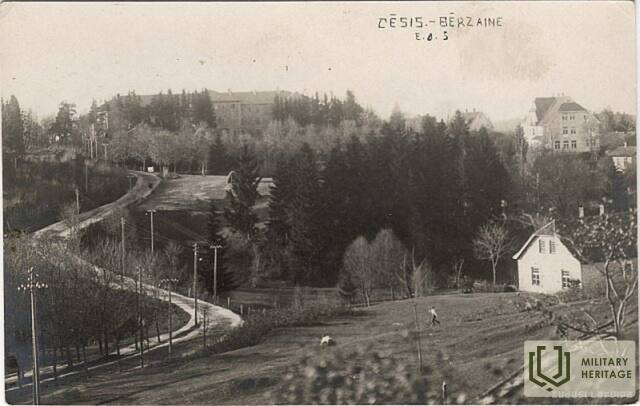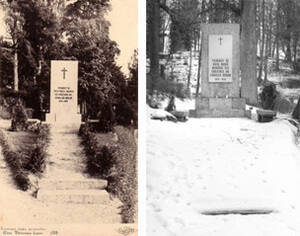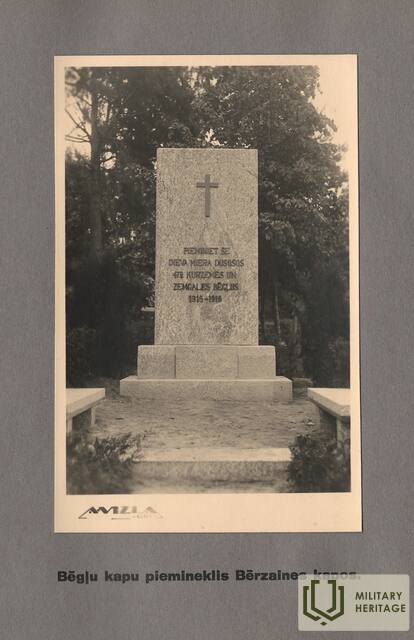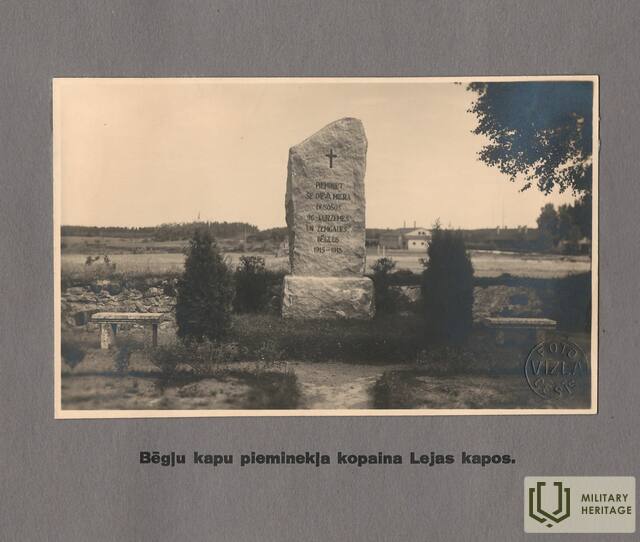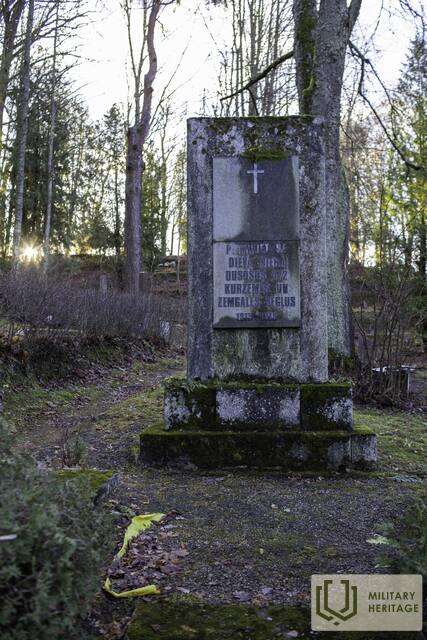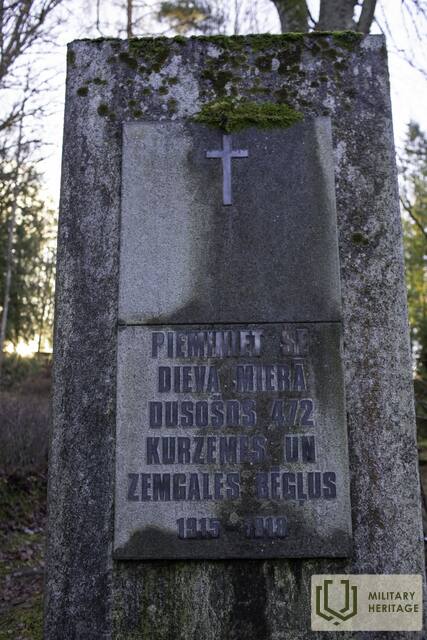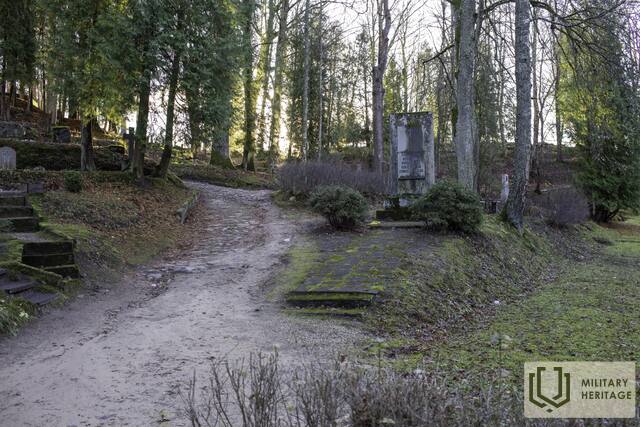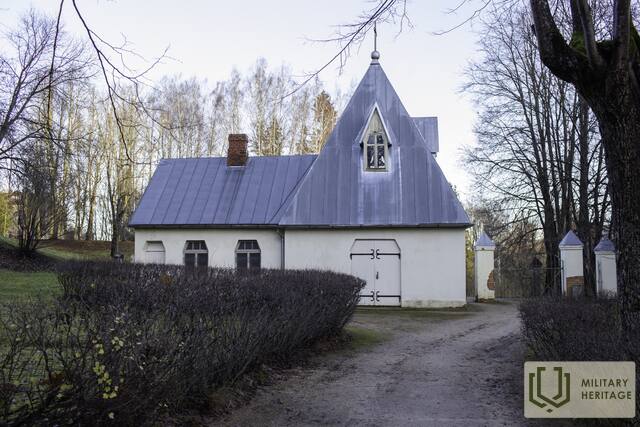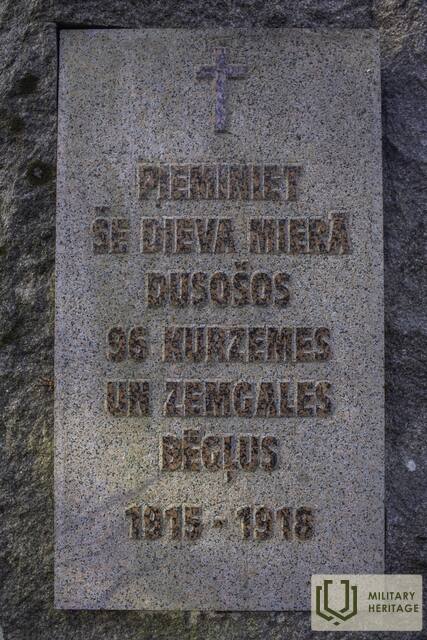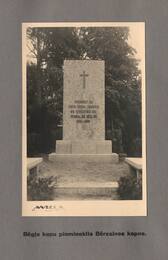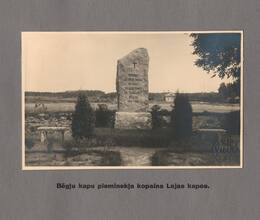Kurzeme ja Zemgale põgenike mälestuspaigad ja matused Cēsises
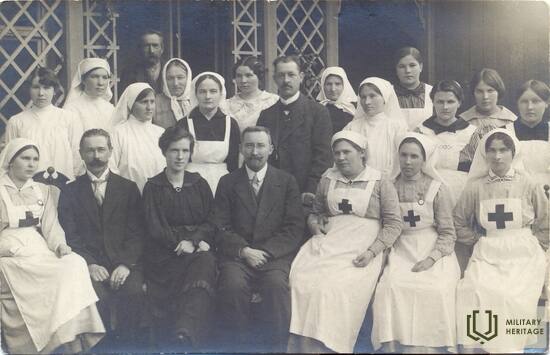
Before the First World War, 2552 thousand people lived in the territory of Latvia. people. The 1920 census registered 1,596 thousand people. people. This means that during this period the population of Latvia had decreased by 956 thousand. people or by 37.5%.
In the summer of 1915, German troops occupied Kurzeme and Zemgale. More than half a million refugees fled their homelands in an endless stream. The first refugees arrived in Cēsis in April 1915.
In 1914, the "Latvian Aid Committee for the City and Surroundings of Cēsis" was established in Cēsis, which in turn was divided into sub-committees: refugee registration, hospitals, kindergarten, catering, shoe-making, etc. The locals who had settled in Cēsis.
From August 1915 to May 2018, the First Refugee Hospital operated in Cēsis, where 2130 patients were treated. On August 24, 1915, a 50-bed refugee hospital and outpatient clinic for communicable diseases was opened in Cēsis, Jaunā (now Piebalgas) Street 6, Dr. med. Led by E. Akermanis (1878-1954). His wife, doctor V. Treigute-Akermane (1883-1970), managed the second refugee infirmary and outpatient clinic opened in Cēsis. In April 1916, Latvian doctors were also represented by Dr. med. E. Akermanis from Cēsis. In a statement to Cēsis Avīze, the Baltic Refugee Supply Committee reminded Cēsis that "patients with especially contagious diseases are immediately admitted to refugee hospitals".
Eba Krēmane, a senior nurse (1875–1942), is mentioned in the memories of that time as a symbol of self-denial and mercy. The pastor prof. Led by Voldemārs Maldoņš (1870-1941).
Despite the efforts, around 700 refugees died in the epidemics alone. They are buried in Leja and Bērzaine cemeteries.
On February 17, 1933, a refugee committee met in Riga, which decided to "act as a unit at the Cēsis City Congregation with the aim of collecting and decorating refugee cemeteries, as well as erecting memorials in Cēsis and surrounding cemeteries."
By May 1935, 6883.20 lats had been donated.
On February 11, 1936, an agreement was made with the sculptor Kārlis Jansons (1896-1986) on the construction of monuments in the cemeteries of Leja and Bērzaine. Both monuments were unveiled on June 14, 1936, and they cost 4,600 lats.
In the lower cemetery, above the base of the square, rises a roughly granite stele, the upper part of which has a bronze cross. Below this is a message in bronze:
REMEMBER
THIS IS GOD IN PEACE
SHOOTING
96 KURZEMES
AND ZEMGALES
REFUGEES
1915-1918
In the Bērzaine cemetery, granite steps lead up a hill, where a steeple rises above the two-step base. On the smoothly treated granite surface there is a bronze cross, under which the words in bronze letters:
REMEMBER HERE
GOD IN PEACE
472 KURZEME AND
ZEMGALE REFUGEES
1915-1918
The return of refugees and prisoners of war began as early as 1919, ie immediately after the establishment of the new Latvian state. However, mass re-emigration took place in 1920-1921. year, when almost 200 thousand people returned. People also went home between 1922 and 1927, but the number of returnees became smaller and smaller.
S.Upīte, P.Pukite, World War I and Freedom Fight Memorial Sites in Cesis District, Cesis Museum Association, 1989
https://www.literatura.lv/lv/person/Voldemars-Maldonis/873554
http://www.muzejs.cesis.lv/lv/jubilaru-pietura-cesis/
http://edruva.lv/piemineklis-berzaines-kapos/
https://lr1.lsm.lv/lv/raksts/siis-dienas-aciim/latviesu-begli-krievija-pirma-pasaules-kara-laika.a55907/
https://www.vestnesis.lv/ta/id/31751
Seotud ajajoon
Seotud teemad
Seotud objektid
Monument Esimese maailmasõja Kurzeme ja Zemgale põgenikele
Asub Bērzaine kalmistul
Kurzeme ja Zemgale Esimese maailmasõja põgenike monument.
17. veebruaril 1933 kogunes Riias pagulaskomitee, kes otsustas "töötada Cēsise linnakoguduse üksusena eesmärgiga koguda ja kaunistada põgenike haudu, samuti püstitada mälestusmärke Cēsise ja linna kalmistutele. ümbritsev ala".
1935. aasta maiks oli annetatud 6883,20 latti.
11. veebruaril 1936 leppis ta skulptor Kārli Jansonsiga kokku monumentide ehitamises Leja ja Bērzaine kalmistule. Mõlemad monumendid avati 14. juunil 1936 ja need läksid maksma 4600 latti.
Bērzaine kalmistu graniittrepid viivad künkale, kus kaheastmelise aluse kohale kõrgub stele. Siledal graniitpinnal paistab pronksrist, mille all pronkstähtedega sõnad:
MINI SIIN
PUHAKS JUMALA RAHUS
472 KURZEMES JA
ZEMGALE PAGULASED
1915-1918
Monument Esimese maailmasõja põgenikele Kuramaas ja Zemgales Leja kalmistul
See asub Cēsise linna alumisel kalmistul.
Kurzeme ja Zemgale Esimese maailmasõja põgenike monument.
Alumisel kalmistul kõrgub neljatahulise aluse kohale krobeliselt tahutud graniidist stele, mille ülemises osas on pronksrist. Selle all on pronkstähtedega sõnum:
JÄTA MEELDE
JUMAL OLGU RAHU
SILITAMINE
96 KURZEEMIST
JA ZEMGALES
PAGULASED
1915-1918
17. veebruaril 1933 kogunes Riias pagulaskomitee, kes otsustas "töötada Cēsise linnakoguduse üksusena eesmärgiga koguda ja kaunistada põgenike haudu, samuti püstitada mälestusmärke Cēsise ja linna kalmistutele. ümbritsev ala".
1935. aasta maiks oli annetatud 6883,20 latti.
11. veebruaril 1936 leppis ta skulptor Kārli Jansonsiga kokku monumentide ehitamises Leja ja Bērzaine kalmistule. Mõlemad monumendid avati 14. juunil 1936 ja need läksid maksma 4600 latti.




